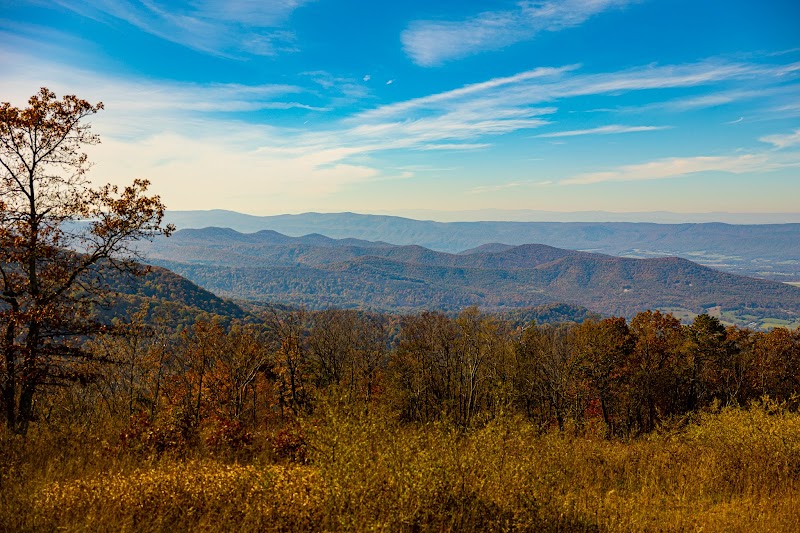
Shenandoah National Park Adventures
Shenandoah National Park offers breathtaking vistas of the Blue Ridge Mountains and lush, expansive woodlands, making it a prime destination for outdoor enthusiasts and nature lovers.
Popular Activities
Exploring the Wild Heart of Shenandoah: A Guide to Camping Adventure
Weaving through the time-carved ridges and lush valleys of Virginia, Shenandoah National Park offers an exhilarating tapestry of wilderness where every brook murmurs tales of adventure, and the Appalachian Mountains rise with an untamed grandeur. There's an embrace of wilderness here that promises both solace and thrill, a playground for the souls eager to commune with nature and challenge its expanses.
Start your journey at one of the Park’s many campgrounds—each a portal into a different aspect of Shenandoah’s diverse landscapes. Big Meadow Campground, with its wide, open expanses, beckons you to immerse yourself in the park's vibrant flora and fauna. Here, the air is crisp, infused with the scent of pine, and layered with the distant calls of wildlife. As the sun dips beneath the horizon, the sky unfurls into a starlit spectacle, an immense canopy of brilliance that feels almost within reach.
For those seeking a more secluded escapade, Loft Mountain Campground is perched on a ridge overlooking panoramic views that stretch beyond the horizon. The climb up Rockfish Gap, flanked by deciduous hardwoods and stone outcrops, welcomes you with whispers of the past carried by the breeze. Pack light, travel smart—enduring footwear and balanced packs are essentials here, as the terrain varies from moss-covered paths to rocky climbs. This site, like many in the park, is equipped with basic amenities yet calls for self-sufficiency—a reminder that the true luxuries of camping lie within the primal comforts of nature.
Embrace the call of the wild trails that guide you through Shenandoah’s expansive heart. The ascent along Old Rag Mountain is both a challenge and a revelation, with switchbacks that hug the mountainside and scramble zones that test agility and resolve. As you crest the summit, the wind becomes a companion, urging you onward while unveiling a sweeping vista of rolling peaks and verdant valleys. The sensation of standing on the mountaintop, amidst rock faces that seem carved by time's steady hand, resonates with a triumph over the demanding journey.
Dive deeper into the park's natural wonders by setting your sights on the backcountry. A permit grants you access to secluded spots where campsites whisper stories of solitude and the night unfolds in a vivid panorama above. The rhythmic symphony of a nearby stream accompanies your thoughts as you plan tomorrow's adventure. Remember, hydration is key in these escapades—carry ample water or a reliable filtration system to safeguard against the thirst that the journey demands.
Each trail and campsite in Shenandoah is a chapter in a larger narrative of adventure. For climbers, the granite cliffs offer an alluring challenge; though the routes are unnamed here, the rock itself will guide you with its ancient whispers. The forest, ever zealous in its invitation, shelters these natural fortresses, challenging your stamina and rewarding your experience with breathtaking views.
Before the journey concludes, venture along Skyline Drive, a twisting path that perfectly encapsulates the spirit of Shenandoah. Each bend in the road opens up vistas that demand pauses, letting the horizon pull at your wanderlust. Seasonal transformations shift the park's narrative; in spring and autumn, bursts of color dance across the forest, enticing adventurers to witness nature’s drama.
Shenandoah National Park is no mere backdrop. It is an invitation to explore, challenge, and reflect—a symphony of wilderness that urges you to write your own chapter in its sprawling adventure saga. With each step along its trails, each evening beneath its sky, Shenandoah protects its stories and promises an experience unmatchable and unforgettable.
Plan Your Visit
Everything you need to know to prepare for an unforgettable trip to Shenandoah National Park.
Entrance Requirements
Fee required; America the Beautiful pass accepted.
Best Time to Visit
Spring and fall for temperate weather and seasonal color; summer for all park amenities.
Visitor Information
Dickey Ridge Visitor Center, Byrd Visitor Center
Getting There
Accessible via US Route 340 and I-66; Skyline Drive may close due to snow and ice.
Weather & Climate
Summers are warm and humid; winters can bring snow and cold temperatures. Fall offers vibrant foliage and mild weather, while spring sees blooming wildflowers and cooler conditions.
Conservation Efforts
Concerns include invasive species, climate change impacting native wildlife, and managing visitor impact to preserve natural resources and habitats.
Camping in Shenandoah National Park
Find the perfect spot to stay overnight and immerse yourself in the details.
Big Meadows
Situated near Byrd Visitor Center with access to several trails.
Matthew's Arm
Closest to the northern entrance of the park, ideal for first-time visitors.
Top Trails
Old Rag Mountain
Features rocky scrambles and a strenuous ascent but offers outstanding summit views.
Hawksbill Mountain
Climb to the highest peak in the park for exceptional vistas.
Dark Hollow Falls
A brief but steep trail leading to picturesque falls.
White Oak Canyon
Pass a series of waterfalls with multiple viewing points along the trail.
Trailblazer Tips
Visit during midweek to avoid weekend crowds on popular trails.
Fall foliage season is spectacular but expect crowded conditions and plan for lodging in advance.
Campground spots fill quickly; reserve as early as you can, especially in peak seasons.
Bring a map and compass, as GPS can be unreliable in remote parts of the park.
